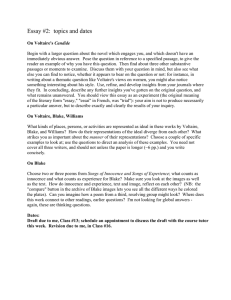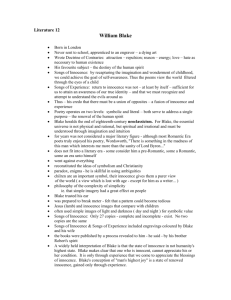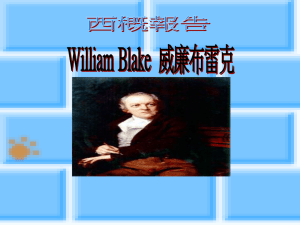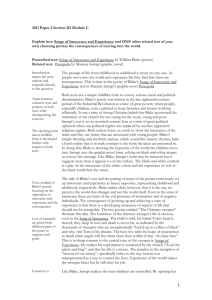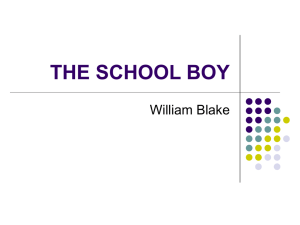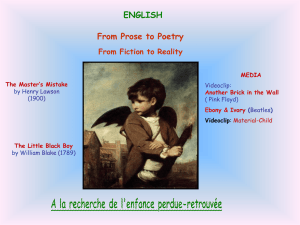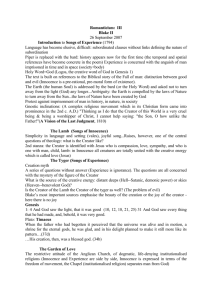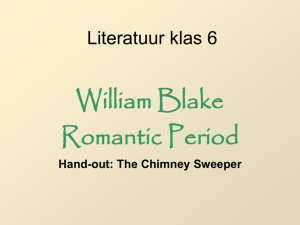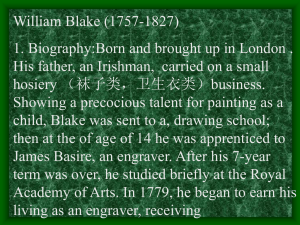Romanticism & William Blake
advertisement
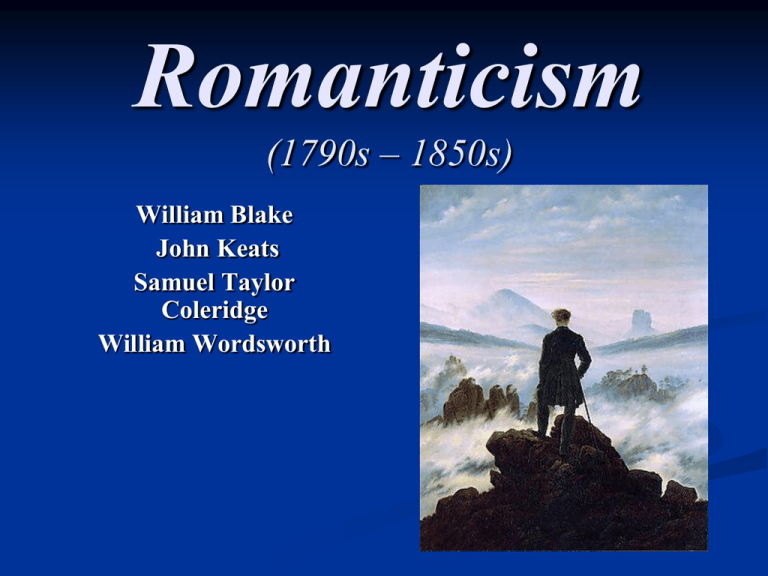
Romanticism (1790s – 1850s) William Blake John Keats Samuel Taylor Coleridge William Wordsworth Historical Context Industrial Revolution – increasing urbanisation as the population moved from the country to the city to work in factories and other industries. French Revolution (1789) – political change seemed a possibility in England with the overthrow of the French Monarchy. Enlightenment – the period in the late 17th and early 18th Centuries in which reason, rationality, and the scientific method was primary. Romanticism as a Response Romanticism was a response to these catalytic events. By understanding the Romantic world view, you are able to gain insight into their poetry. “Politically it [Romanticism] was inspired by the revolutions in America and France…Emotionally it expressed an extreme assertion of the self and the value of the infinite and transcendental. Socially it championed progressive causes…The stylistic keynote of Romanticism is intensity, and its watchword is ‘Imagination’”. (from The Oxford Companion to English Literature ed. Margaret Drabble, 1985) Form of the Responses Music Ludwig Van Beethoven, Felix Mendhelssohn, Fran Schubert. Art John Constable, William Turner, Eugene Delacroix. Literature Mary Shelley’s Frankenstein, the poetry of William Blake, John Keats, Samuel Taylor Coleridge, William Wordsmorth, Percy Bysse Shelley, Lord Byron. Primary Concerns 1. 2. 3. 4. 5. VISIONARY EXPERIENCES: They strongly valued a personal viewpoint that was often imagnitavie and visionary. EMOTIONS: Intense emotional experiences were very important, such love, death and melancholy. INNOCENCE: They admired the sense of innocence found in children. NATURE: At a time when nature was threatened by the Industrial Revolution, it acquired great value. SOCIAL COMMENTARY: They critiqued and challenged the dominant social values. William Blake Poet, Artist, Visionary Who was William Blake? “William Blake (1757-1827) was an English poet, painter and engraver (printmaker). Largely unrecognised during his life-time, Blake is now considered a seminal figure in the history of both poetry and visuals arts of the Romantic Age….Although he only once journeyed farther then a day’s walk outside London during his lifetime, he produced a diverse and symbolically rich corpus, which embraced ‘imagination’ as the ‘the body of God’ or ‘Human existence itself’.” (<www.wikipedia.org> accessed on 02/06/09) Songs of Innocence and Experience ACTIVITY (5 minute brainstorm activity) 1. What images or symbols represent innocence to you? Why? 2. How is experience different? Why? Songs of Innocence and Experience “Holy Thursday” from Songs of Innocence Twas on a Holy Thursday their innocent faces clean, The children walking two & two in red & blue and green, Grey headed beadles walked before with wands as white as snow; Till into the high dome of Pauls they like Thames waters flow. Oh what a multitude they seemd, those flowers of London town! Seated in companies they sit with radiance all their own. The hum of multitudes was there but multitudes of lambs: Thousands of little boys & girls raising their innocent hands. Now like a mighty wind they raise to heaven the voice of song, Or like harmonious thunderings the seats of heaven among. Beneath them sit the agéd men wise guardians of the poor. Then cherish pity; lest you drive an angel from your door. “London” from Songs of Experience I wander thro’ each charter’d street, Near where the charter’d Thames does flow, And mark in every face I meet, Marks of weakness, marks of woe. In every cry of every Man, In every Infants cry of fear, In every voice, in every ban, The mind-forg’d manacles I hear: How the Chimney-sweeper's cry Every blackening Church appalls, And the hapless Soldiers sigh Runs in blood down Palace walls. But most thro’ midnight streets I hear How the youthful Harlot's curse Blasts the new-born Infants tear, And blights with plagues the Marriage hearse. CLOSE READING ACTIVITY 1. 2. Annotate your copy of each poem by William Blake using the 10 Step Analysis Grid to guide you. Compare and contrast Blake’s presentation of innocence versus experience in these two poems. Checklist Have you considered these as you read Blake’s poetry? • Subject Matter • Key Ideas (purpose) • Tone (emotion/ mood) • Techniques • Structure • Sensory Appeal • Language • Imagery • Rhythm (movement) • Sounds HINT 1: Think of the grid like a mental checklist. HINT 2: Focus on which techniques are the most predominant in the poem? References Page, Geoff. 80 Great Poems: From Chaucer to Now. UNSW Press, 2006. Stevens, David. Romanticism. (Cambridge Contexts in Literature). CUP, 2004. Putner, David. Songs of Innocence and Experience – William Blake. (York Notes Advanced), CUP, 2003.
